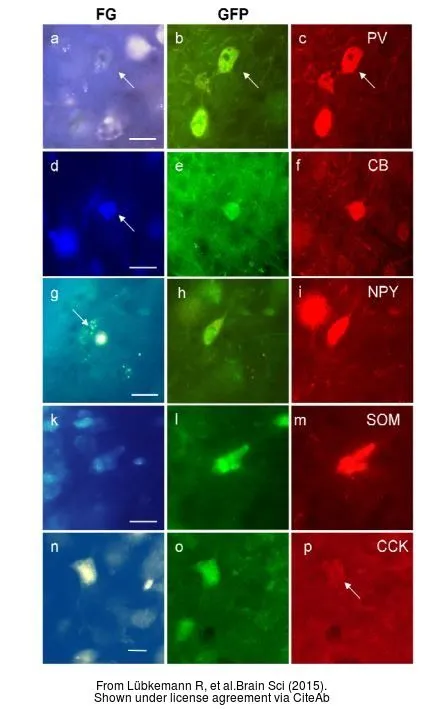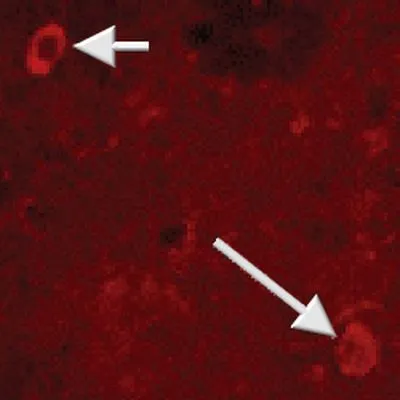
The data was published in the journal Brain Sci in 2015. PMID: 26264032
Neuropeptide Y antibody
GTX10980
ApplicationsELISA, ImmunoHistoChemistry, ImmunoHistoChemistry Frozen
Product group Antibodies
TargetNpy
Overview
- SupplierGeneTex
- Product NameNeuropeptide Y antibody
- Delivery Days Customer9
- Application Supplier NoteIHC-Fr: 1:8,000-1:16,000. ELISA: 1:5,000-1:10,000. *Optimal dilutions/concentrations should be determined by the researcher.Not tested in other applications.
- ApplicationsELISA, ImmunoHistoChemistry, ImmunoHistoChemistry Frozen
- CertificationResearch Use Only
- ClonalityPolyclonal
- ConjugateUnconjugated
- Gene ID24604
- Target nameNpy
- Target descriptionneuropeptide Y
- Target synonymsNPY02; pro-neuropeptide Y; pro-neuropeptide Y-like; RATNPY; RATNPY02
- HostRabbit
- IsotypeIgG
- Protein IDP07808
- Protein NamePro-neuropeptide Y
- Scientific DescriptionNPY, a 36 amino acid peptide amide isolated from porcine brain, is a major regulatory neuropeptide in the mammalian central and peripheral nervous systems. NPY belongs to the pancreatic polypeptide family of peptides which are characterized by a common tertiary structure. Within this family, an intestinal peptide hormone, Peptide YY (PYY), is most closely related to NPY. In the central nervous system (CNS) NPY is considered to be involved in many central processes including regulation of blood pressure, memory processing, circadian rhythm, and stimulation of food intake. In the peripheral nervous system (PNS), NPY evokes potent vasoconstrictor activity and acts as a neurotransmitter/neuromodulator of sympathetic neurons and adrenal glands. NPY is one of the most abundant peptides found in the CNS. NPY and NPY mRNA are widely distributed in the brain. High levels of NPY are present in the cerebral cortex, amygdaloid nuclei, hippocampal formation, and hypothalamus. In the PNS, NPY is widely distributed in sympathetic neurons that innervate vascular smooth muscle, heart, and urogenital tract. In these neurons NPY is mainly co-localized with norepinephrine and is considered to function as a neurotransmitter to pre-synaptically inhibit nor adrenergic neurotransmission. The biological actions of NPY in the brain and periphery are mediated by at least two different NPY receptors, designated Y1 and Y2 receptor subtypes. Cardiovascular effects and centrally evoked food intake potential are activities predominantly mediated by the Y1 receptors, whereas the Y2 receptors, the major subtype in the CNS, are mainly involved in the pre-synaptic inhibition of neurotransmitter release and facilitation of memory retention. Post- synaptic NPY receptors are apparently of both the Y1 and Y2 type. NPY receptors are coupled to at least two different signal transduction mechanisms, the adenylate cyclase pathway (decrease in cAMP), and the phosphoinositol/IP3 pathway. Antibodies that react specifically with NPY are useful for the study of the mode of action, differential tissue expression, and intracellular and subcellular localization of NPY in the central and peripheral nervous systems.
- Storage Instruction-20°C or -80°C,2°C to 8°C
- UNSPSC12352203
References
- Short-term environmental enrichment enhances synaptic plasticity in hippocampal slices from aged rats. Stein LR et al., 2016 Aug 4, NeuroscienceRead more
- Identification and Characterization of GABAergic Projection Neurons from Ventral Hippocampus to Amygdala. Luebkemann R et al., 2015 Jul 31, Brain SciRead more
- Direct and indirect effects of neuropeptide Y and neurotrophin 3 on myelination in the neonatal brains. Hashimoto R et al., 2011 Feb 10, Brain ResRead more

